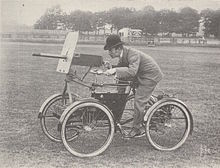
An armoured fighting vehicle or armored fighting vehicle (AFV) is an armed combat vehicle protected by armour, generally combining operational mobility with offensive and defensive capabilities. AFVs can be wheeled or tracked. Examples of AFVs are tanks, armoured cars, assault guns, self-propelled artilleries, infantry fighting vehicles (IFV), and armoured personnel carriers (APC).

A military armoredcar is a lightweight wheeled armored fighting vehicle, historically employed for reconnaissance, internal security, armed escort, and other subordinate battlefield tasks. With the gradual decline of mounted cavalry, armored cars were developed for carrying out duties formerly assigned to light cavalry. Following the invention of the tank, the armored car remained popular due to its faster speed, comparatively simple maintenance and low production cost. It also found favor with several colonial armies as a cheaper weapon for use in underdeveloped regions. During World War II, most armored cars were engineered for reconnaissance and passive observation, while others were devoted to communications tasks. Some equipped with heavier armament could even substitute for tracked combat vehicles in favorable conditions—such as pursuit or flanking maneuvers during the North African Campaign.

The Daimler Company Limited, before 1910 known as the Daimler Motor Company Limited, was an independent British motor vehicle manufacturer founded in London by H. J. Lawson in 1896, which set up its manufacturing base in Coventry. The company bought the right to the use of the Daimler name simultaneously from Gottlieb Daimler and Daimler-Motoren-Gesellschaft of Cannstatt, Germany. After early financial difficulty and a reorganisation of the company in 1904, the Daimler Motor Company was purchased by Birmingham Small Arms Company (BSA) in 1910, which also made cars under its own name before the Second World War. In 1933, BSA bought the Lanchester Motor Company and made it a subsidiary of the Daimler Company.

The Audi A2 (internally designated Typ 8Z) is a lightweight compact MPV-styled supermini car, with a five-door hatchback body style and four or five seats, produced by the German manufacturer Audi from November 1999 (for the 2000 model year) to August 2005. Based on the Audi Al2 concept car first shown at the Frankfurt Motor Show in 1997, the A2 was notable for being constructed from aluminium, which in combination with its efficient engines, made it an extremely economical car on fuel.

The Schwerer Panzerspähwagen, is a series of six- and eight-wheeled armoured cars that were used by Germany during the Second World War.

The Rolls-Royce Armoured Car is a British armoured car developed in 1914 and used during the First World War, Irish Civil War, the inter-war period in Imperial Air Control in Transjordan, Palestine and Mesopotamia, and in the early stages of the Second World War in the Middle East and North Africa.

The T-70 is a light tank used by the Red Army during World War II, replacing both the T-60 scout tank for reconnaissance and the T-50 light infantry tank for infantry support. The T-80 light tank was a more advanced version of the T-70 with a two-man turret—it was produced only in very small numbers when light tank production was abandoned. The T-90 self-propelled anti-aircraft gun was a prototype vehicle with twin machine guns, based on the T-70 chassis.
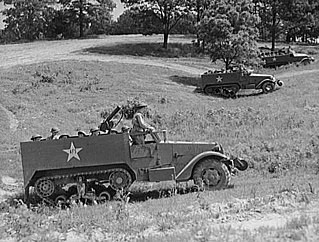
The M3 half-track was an American armored personnel carrier half-track widely used by the Allies during World War II and in the Cold War. Derived from the M2 half-track car, the M3 was extensively produced, with about 15,000 standard M3s and more than 38,000 variant units manufactured.

The M8 light armored car is a 6×6 armored car produced by the Ford Motor Company during World War II. It was used from 1943 by United States and British forces in Europe and the Pacific until the end of the war. The vehicle was widely exported and as of 2006 still remained in service with some countries.

The Daimler Scout Car, known in service as the Daimler Dingo, is a British light, fast four-wheel drive reconnaissance vehicle also used for liaison during the Second World War.

The Mitsubishi Pajero is a full-size SUV manufactured and marketed globally by Mitsubishi over four generations — introduced in 1981 and discontinued in 2021.

The Škoda Octavia is a small family car (C-segment) produced by the Czech car manufacturer Škoda Auto since the end of 1996. It shares its name with an earlier model produced between 1959 and 1971. Four generations of the modern-era Octavia model have been introduced to date, delivered with five-door liftback or five-door estate styles only. The car is front engined, both front- or four-wheel drive are offered. Around five million units have been sold in its two decades of presence on the market. The Octavia is Škoda's most popular model; about 40% of all newly manufactured Škoda cars are Octavias.

The BRDM-1 is a Soviet amphibious armored scout car. It was the first purpose-built Soviet reconnaissance vehicle to enter service since the BA-64 and was built on the chassis and drive train of the BTR-40 armored personnel carrier. It is the world's first mass-produced combat vehicle of its class.
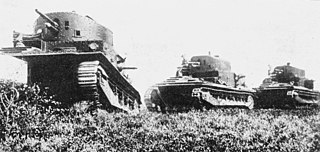
The Vickers Medium Mark I was a British tank of the Inter-war period built by Vickers from 1924.
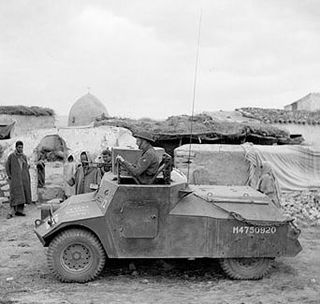
Morris Light Reconnaissance Car (LRC) was a British light armoured car for reconnaissance use produced by Morris Motors Limited and used by the British during the Second World War.
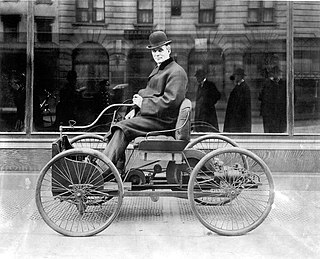
The Ford Quadricycle was the first vehicle developed by Henry Ford. Ford's first car was a simple frame with a gas-powered engine and four bicycle wheels mounted on it.
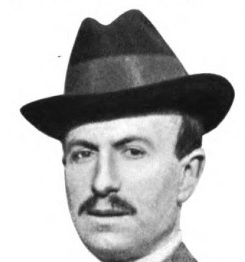
Frederick Richard Simms was a German mechanical engineer, businessman, prolific inventor and motor industry pioneer. Simms coined the words "petrol" and "motorcar". He founded the Royal Automobile Club, and the Society of Motor Manufacturers and Traders.

The Gladiator Cycle Company, Clément-Gladiator, was a French manufacturer of bicycles, motorcycles and cars based in Le Pré-Saint-Gervais, Seine.

The Simms Motor War Car was the first armoured car ever built, designed by F. R. Simms.

The Minerva Armoured Car was a military armoured car expediently developed from Minerva civilian automobiles by Belgium at the start of the First World War.
